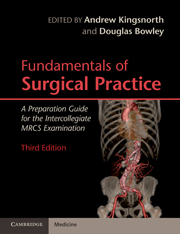Book contents
- Frontmatter
- Contents
- List of contributors
- Preface
- Section 1 Basic Sciences Relevant to Surgical Practice
- Section 2 Basic Surgical Skills
- 5 Surgical techniques and technology
- 6 Professionalism – including academic activities: clinical research, audit, consent and ethics
- 7 Fundamentals of palliative and end of life care
- Section 3 The Assessment and Management of the Surgical Patient
- Section 4 Perioperative Care of the Surgical Patient
- Section 5 Common Surgical Conditions
- Index
- References
5 - Surgical techniques and technology
Published online by Cambridge University Press: 03 May 2011
- Frontmatter
- Contents
- List of contributors
- Preface
- Section 1 Basic Sciences Relevant to Surgical Practice
- Section 2 Basic Surgical Skills
- 5 Surgical techniques and technology
- 6 Professionalism – including academic activities: clinical research, audit, consent and ethics
- 7 Fundamentals of palliative and end of life care
- Section 3 The Assessment and Management of the Surgical Patient
- Section 4 Perioperative Care of the Surgical Patient
- Section 5 Common Surgical Conditions
- Index
- References
Summary
Skin preparation
Traditional skin preparation involved fastidious cleansing with preoperative bathing, shaving of the surgical area and, particularly for orthopaedic operations, cleaning of the skin with antiseptic solutions and covering with sterile bandages. Some of these practices have been abandoned, largely due to the fact that patients are now often admitted on the morning of their planned day for surgery; however, those for which good supportive evidence exists form the basis for best practice today.
Preoperative bathing in antimicrobial solutions lowers skin colonization and reduces wound infection rates particularly when combined with not shaving the surgical site. Evidence suggests that routine surgical shaving may actually increase the incidence of wound infections by producing microscopic skin abrasions at the surgical site. Hair removal should therefore be limited to the immediate surgical site and be performed either with depilatory agents or by clipping, as close to the time of surgery as possible.
Immediately prior to any procedure the skin is cleaned with an antiseptic solution, commonly either povidone iodine or chlorhexidine. A small number of patients are allergic to these solutions and therefore careful attention to known hypersensitivities is essential. Testing on a remote area of skin 24 h beforehand will exclude any resulting hyperaemia; however, this is often difficult to achieve in practice and therefore in any patient in whom there is clinical suspicion of hypersensitivity 10% alcohol on its own can be used.
- Type
- Chapter
- Information
- Fundamentals of Surgical PracticeA Preparation Guide for the Intercollegiate MRCS Examination, pp. 71 - 93Publisher: Cambridge University PressPrint publication year: 2011



